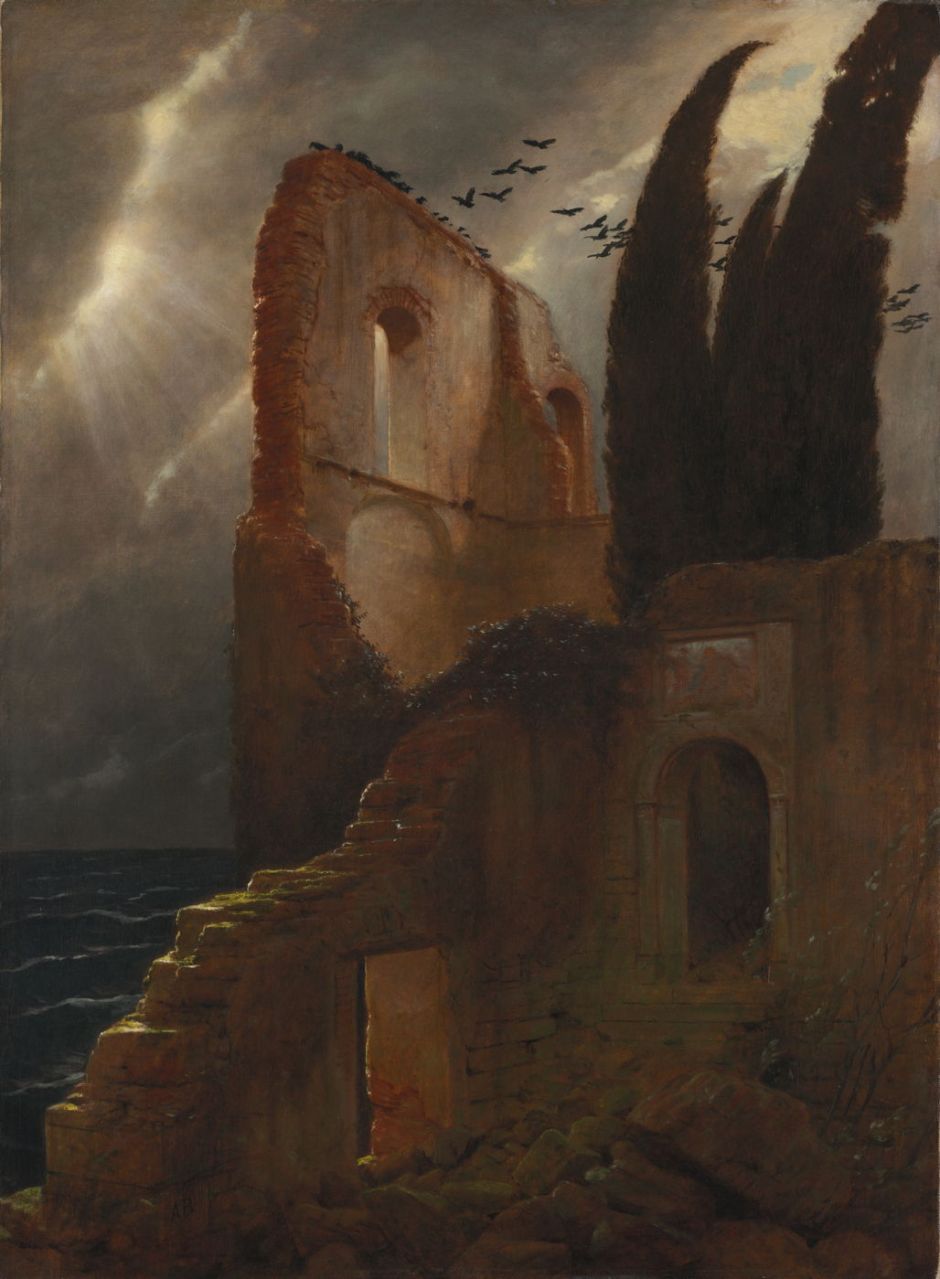The lore of trees is a large and absorbing subject which helps you read the landscape and its paintings. Visit many old churches in Britain and you’ll find an ancient yew in the yard, but across much of the more southern parts of Europe, the tree most strongly associated with churchyards and graveyards is the cypress. These can assume various shapes and forms, but their signature appearance in paintings is instantly recognisable.
Their origin is attributed in classical Greek myth to a pederastic relationship between the god Apollo and a boy named Kyparissos, Latinised to Cyparissus. The most popular account is that of Ovid in his Metamorphoses. Cyparissus had been the love of Apollo, and had befriended a majestic giant stag which he led to pasture and occasionally rode around. In the middle of a hot summer’s day, when the stag was asleep, Cyparissus accidentally killed it with his javelin. The youth was heartbroken, so was transformed into a cypress tree, which has since grown in and by cemeteries, and other places of grief.

Claude-Marie Dubufe’s Apollo and Cyparissus (1821) tackles this difficult story. Apollo is comforting the youth, who appears to be almost dying of grief for the dead stag, on whose body he is resting.
Cypresses occur sporadically throughout landscape paintings, but their association seems to have largely passed uncelebrated until the late nineteenth century, when they came to feature in a succession of significant works. Among the first of these are Arnold Böcklin’s several paintings of Villa by the Sea, the first of which he completed in 1864.

Böcklin’s first version was made using a mixture of encaustic (wax) paints and resins, and hasn’t aged well. For this second version he used conventional oil paints, making it more enduringly readable. The villa appears overgrown and partly in ruins, its cypress and other trees leaning away from the prevailing wind. The woman, dressed in black, is cradling her head with one hand as she looks at the sea.

In another version painted between 1871-74, now in the Städel in Frankfurt, it is last light, with a band of cloud on fire with the last rays of the setting sun. Although the garden of the villa is well-grown, it appears in much better condition, and the woman still stands staring at the sea. Their reading remains the subject of speculation, but their stately cypresses tell of grief.

Böcklin’s use of cypresses extends to his Ruin by the Sea from 1881. The ruins of an old building are just above the waves. Growing within the broken walls are three cypress trees which lean away from the prevailing wind. Above them the sun’s rays break through banks of cloud in a dramatic light, and a large flock of crows are arriving to perch on the top of the walls.
This culminated in his greatest painting, which he made in a total of five different versions over the period between 1880 and 1886: Island of the Dead.

Each shows a similar island, probably based in part on the English Cemetery in Florence, where Böcklin’s own baby daughter had been buried. Each shows the deceased being rowed across to the island, which calls on the classical myth of Charon, who rows the dead over the rivers Styx and Acheron to the underworld. This fifth version was commissioned by the Museum of Fine Arts in Leipzig, and was painted in 1886.
Other contemporary artists incorporated prominent cypress trees for their association with death and grief.

One of three similar paintings made by Evelyn De Morgan, this shows an androgynous angel of death, holding in their right hand the scythe so feared by us all, comforting a seated young woman. The landscape at the left of the painting appears dry and barren, with just three daisy flowers visible. That to the right of the angel is better watered, more fertile, and has richer flowers. This has been interpreted as indicating that the woman’s past was tough, but that her imminent death will offer her a better future. Either way, there will be the grief marked by the cypress trees.

Not usually known for landscapes, when Elihu Vedder was living in Italy, probably during the 1880s, he painted this plein air oil sketch of Cypress and Poppies. Given his Symbolism, I think this combination was significant in terms of its reading.
In the late 1880s, Vincent van Gogh’s attention turned to the cypress.

Orchard (in Blossom) Bordered by Cypresses (1888) is one of a pair of very similar paintings from the same period which introduces, in the background at first, a popular theme of van Gogh’s, cypress trees.
The following year, when van Gogh was in the Saint-Paul-de-Mausole mental asylum at Saint-Rémy near Arles, he could see through a window a view of wheatfields and dark Provençal cypress trees, with the Alpilles Mountains in the distance. During a period of intense creativity in June and July of 1889, he first drew parts of this view, then turned those drawings into paintings.

Perhaps this pen-and-ink drawing (above) was his first take, showing these two cypresses almost superimposed. From this, he made a painting in oils (below), which follows it closely.

My second and concluding article will start from there, showing how van Gogh’s cypresses developed, and where they led others.

